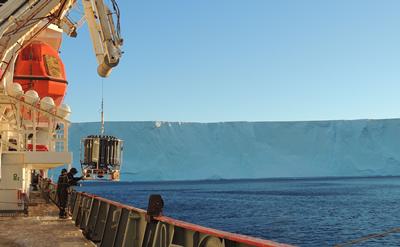Scientists unravel the process of meltwater in ocean depths

An international team of researchers has discovered why fresh water, melted from Antarctic ice sheets, is often detected below the surface of the ocean, rather than rising to the top above denser seawater.
The research, led by the University of Southampton, is published this week in the journal Nature in association with colleagues at the National Oceanography Centre, Southampton, University of East Anglia (UEA), British Antarctic Survey and Stockholm University. The team found that the Earth’s rotation influences the way meltwater behaves – keeping it at depths of several hundred metres.
Professor Alberto Naveira Garabato, of Ocean and Earth Science at the University of Southampton and lead author of the study, says: “We believe our study is an important step in understanding how the meltwater mixes in the ocean and will help with the design of climate models, which largely assume meltwater is only present on the surface of oceans. Our research emphasises its detection at greater depths and explains why it is found there.”
The researchers made their discovery during an expedition in the Southern Ocean, led by Professor Karen Heywood of UEA, on British Antarctic Survey’s Royal Research Ship James Clark Ross. The trip was undertaken in 2014 as part of the NERC-funded iSTAR programme. The team measured turbulence experienced by meltwater as it flowed out of a cave beneath the Pine Island Glacier – one of the fastest melting glaciers in Antarctica. They used a VMP23 (Vertical Microstructure Profiler) to detect subtle fluctuations in the water.

The scientists discovered the meltwater ends up settling hundreds of metres down, because as it tries to rise above the surrounding denser seawater, it is affected by the Earth’s rotation. This makes it spin very quickly around its vertical axis, resulting in the ejection of meltwater filaments in a sideways motion into the surrounding sea – preventing the water from rising to the surface.
Scientists are interested in the depth at which water from Antarctic ice sheets enters the ocean because it has differing effects on global ocean circulation and climate. Surface meltwater makes the upper layers of the Southern Ocean lighter. This is thought to slow down the sinking of those waters in the region, and to favour the expansion of Antarctic sea ice. Injecting the same meltwater at depth is believed to have the opposite effect, favouring sinking of surface waters and the retreat of Antarctic sea ice.
Dr Alexander Forryan, also of the University of Southampton, comments: “The effect of meltwater on climate was taken to the extreme and popularised in the Hollywood blockbuster ‘The Day After Tomorrow’. While no one expects our climate to change in the space of a few days, like the movie – we do know that fresh water flowing into our seas could dramatically affect sea levels and ocean circulation. As such, it is vital our models take into account the presence of both surface and deep meltwater to maximise their accuracy.”
The team now hope to develop a way to represent the process in climate models, so that climate modellers can reliably investigate the impact of the melting of Antarctica on our changing climate.
Related Staff Member
Related Staff Member
Notes for editors
1) This research was funded by the NERC iSTAR Programme, which aims to improve understanding of what’s happening to the area of the West Antarctic Ice Sheet where the greatest rates of ice loss over the last decades have been observed. New knowledge about the stability of this ice sheet is critical for making better predictions about how the ocean and ice will respond to environmental change, and what impact this may have on future sea level. iSTAR is an ambitious scientific programme funded by the Natural Environment Research Council (NERC). It brings together leading scientists from 11 UK universities and from British Antarctic Survey (BAS).
2) This latest paper forms part of an iStar project called Ocean2ice, led by Professor Karen Heywood of the University of East Anglia.

